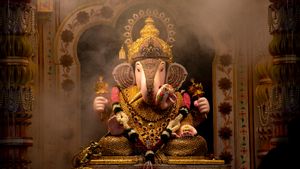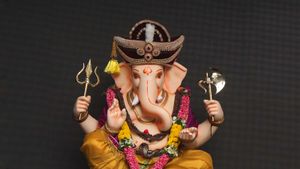Much like 2020, Lord Ganesha will give darshan via online platforms to his devotees in Pune and across India during the Ganeshotsav 2021. This year, the 11-day Ganpati festival begins on September 10, 2021, and ends on September 21, 2021.
We’ve compiled the links to the idols of the five most revered and popular (manache) Ganpati idols in Pune – Kasbapeth, Tambdi Jogeshwari, Guruji Talim, Tulshibaug, and Kesariwada – so you don’t miss your annual visit to these pandals.
Shri Kasba Ganpati Sarvajanik Ganeshotsav Mandal
The ‘grama-devata’ (a deity believed to protect locals from evil forces) of Pune, Kasba Ganpati, was declared the first (manacha) Ganpati of Pune by Lokmanya Tilak, the father of Indian Renaissance, and the founder of Sarvajanik Ganeshotsav. This mandal’s story goes back to the 17th century when Chhatrapati Shivaji Maharaj’s mother Rajmata Jijabai Bhosle, along with seven other families of their clan, arrived in Pune’s Kasba Peth and found an idol of Lord Ganesha there. The Rajmata took this discovery as an auspicious omen, since Lord Ganesha is synonymous with new beginnings, and instructed her men to build their colony around the area and to build a temple for the idol too.
Shree Tambdi Jogeshwari Ganeshotsav Mandal
Second, in line is the idol at Tambdi Jogeshwari Temple, located in Appa Balwant Chowk in Pune. This Ganpati pandal holds significance because the idol is established every year in the Tambdi Jogeshwari Temple, which is a place of worship dedicated to Goddess Durga, the gram-devi (a deity believed to protect locals from evil forces) of Pune. This temple was built in 1545 A.D. by Trimbrak Bendre.
When Tilak started community celebrations for Ganpati, this was the place where he established a Ganesha idol and made it the second most revered (manacha) Ganpati in the city. Ever since the idol is funded by the temple trust and is being designed by the Gulunjkar family of Pune. In the pre-pandemic time, the idol used to be carried on a silver bandwagon for immersion.
Guruji Talim Mandal
Located on Laxmi Road in Pune, Guruji Talim Mandal is the third manacha Ganpati and is a symbol of Hindu-Muslim unity and communal harmony in the city. The idol was first established by Bhiku Pandurang Shinde, Nanasaheb Khasgiwale and Sheikh Lalabhai in 1887, long before Tilak started community celebrations. Over the years, the mandal has become a must-visit among the people of Pune and beyond for its appealing themed decorations, which are based on current affairs and trends.

Sri Tulshibaug Maha Ganpati Mandal Trust
Tulshibaug Maha Ganpati is the fourth manacha Ganpati. It was established in 1901 by Aba Khatavkar, Sadashiv Pawar and Boloba Walke in the heart of one of Pune’s oldest commercial localities – Budhwar Peth – and has got its name from the Tulshibaug Wada. Local traders and shopkeepers believe that the Tulshibaug Ganpati is the real reason why their businesses continue to flourish.
Kesari Wada Ganpati
The fifth and final manacha Ganpati of Pune is the one at Kesariwada in Narayan Peth. It was established in 1894 by Tilak and this is where the Sarvajanik Ganeshotsav started not only in Pune but all over Maharashtra. For the Pune of people, the Kesariwada Ganpati represents the freedom struggle that the city witnessed during the British era, and hence, it is a significant part of the most revered and manache Ganpati of Pune.

Disclaimer: The details mentioned throughout this blog are sourced from publicly accessible platforms. At Zeezest, we intend to share factual and verified information. Should there be any inconsistencies or variances in the information provided, please understand that these are entirely unintentional and not meant to mislead.




